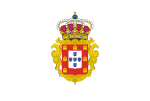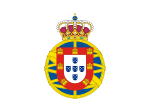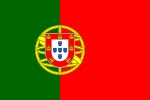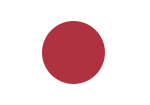Flag of East Timor
You can help expand this article with text translated from the corresponding article in German. (December 2010) Click [show] for important translation instructions.
|
 | |
| Use | National flag and ensign |
|---|---|
| Proportion | 1:2 |
| Adopted | 28 November 1975 (de facto) 19 May 2002 (de jure) |
| Design | A red field with the black isosceles triangle based on the hoist-side bearing a white five-pointed star in the center superimposed on the larger yellow triangle, also based on the hoist-side, that extends to the center of the flag. |
The national flag of East Timor (Portuguese: Bandeira de Timor-Leste) is one of the official symbols of East Timor. It consists of a red field with the black isosceles triangle based on the hoist-side bearing a white five-pointed star in the center superimposed on the larger yellow triangle, also based on the hoist-side, that extends to the center of the flag.
History
The flag of East Timor was adopted in 2002. It is the same as the flag that was originally adopted when the country declared its independence from Portugal in 1975, nine days before being invaded by Indonesia.[1] At midnight on 19 May 2002, and during the first moments of Independence Day the next day, the United Nations flag was lowered and the flag of an independent East Timor was raised.
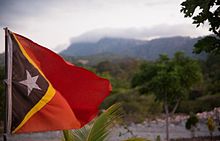
As per the Constitution of East Timor, the yellow (PMS 123) triangle represents "the traces of colonialism in East Timor's history". The black triangle represents "the obscurantism that needs to be overcome"; the red (PMS 485) base of the flag represents "the struggle for national liberation"; the star, or "the light that guides", is white to represent peace.
Official description of the flag
According to the Constitution of the Democratic Republic of East Timor, Part I, Section 15:
- "The national flag is rectangular and is formed by two isosceles triangles, the bases of which are overlapping. One triangle is black and its height is equal to one-third of the length overlapped to the yellow triangle, whose height is equal to half the length of the Flag. In the centre of the black triangle there is a white star of five ends, meaning the light that guides. The white star has one of its ends turned towards the left side end of the flag. The remaining part of the flag is red."[2]
Historical flags
-
The flag of Portugal, as adopted in 1667, was used in Portuguese Timor 1702–1707
-
The flag of Portugal, as adopted in 1707, was used in Portuguese Timor 1707–1750
-
The flag of Portugal, as adopted in 1750, was used in Portuguese Timor 1750–1816
-
The flag of Portugal, as adopted in 1816, was used in Portuguese Timor 1816–1830
-
The national flag of Portugal, as adopted in 1830, was used in Portuguese Timor 1830–1910
-
The flag of Portugal, adopted in 1910, was used in Portuguese Timor 1910–1975
-
Flag of Japan used in during Japan's occupation of Portuguese Timor (1942–1945)
-
War flag of the Imperial Japanese Army (1942–1945)
-
1965 proposal for a flag of Portuguese Timor (never adopted)
-
Flag used following unilateral declaration of independence, nine days before the Indonesian invasion (28 November 1975 – 7 December 1975)
-
Flag of East Timor as the province of Timor Timur, during subsequent Indonesian occupation (1976–1999)
-
The Flag of the United Nations, used by East Timor under UN administration (1999–2002)
Other flags

A different flag had been suggested by the representatives of the Timorese political parties and organisations during the first East Timorese National Convention held in April 1998 in Portugal. This flag was originally the flag of CNRT (Conselho Nacional de Resistência Timorense, National Council of Timorese Resistance). Because of CNRT's popularity, there was a consensus of the participants of the Convention to adopt their flag as a temporary flag for East Timor. It was replaced by the former design of 1975 in 2002.
References
- ^ Complete Flags of the World. Dorling Kindersley. 1997. p. 279. ISBN 978-1-4093-5371-3.
- ^ "CONSTITUTION OF THE DEMOCRATIC REPUBLIC OF EAST TIMOR". Constitution.org. Retrieved 9 January 2018.
External links



